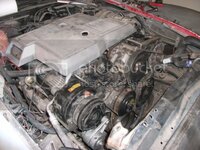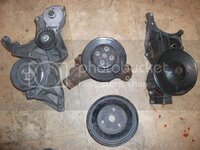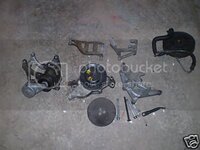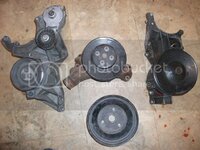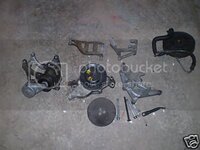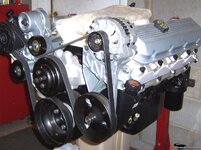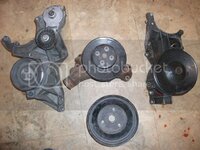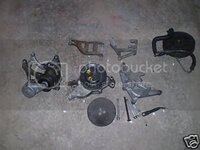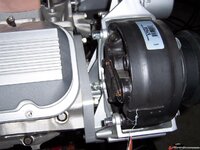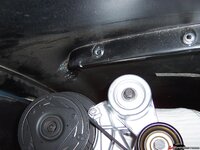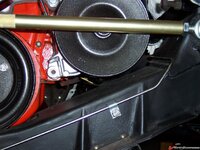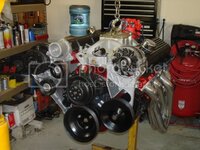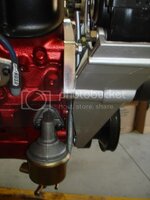68/70Vette
Well-known member
Problem: You want to make a bracket that bolts into an existing hole in the cylinder head (forward facing surface) and an existing hole in the engine block (forward facing surface). For the raw undrilled bracket, you've got to drill two holes (in this simple example) where the centerlines of the holes are exactly aligned to the existing cylinder/block holes. How to?
Short tutorial: Buy an October 2012 copy of Hot Rod magazine. Go to page 132 and read the "how to" article. What are the size of the head/block holes - diameter and pitch you're working with? Go to Amazon.com and buy the Heimann Transfer Screw set for this diameter/pitch.
http://www.amazon.com/s/ref=nb_sb_s...transfer+screws&sprefix=heiman+transf,aps,307
Longer tutorial: Insert (screw in) the transfer screw into the cylinder head hole and screw another into the block hole. "Transfer screw" is, to me, not very descriptive. The so called transfer screw is really a plug. On it's outward facing surface, it has a small conical shaped protrusion. When you screw in the plug, the small conical shaped protrusion extends above the surface of the cylinder head/block. The tip of the conical protrusion is sharp and hardened. Now lay your undrilled bracket blank on top of the two protruding tips. Bang the bracket with a mallet. The surface of your blank bracket will now have two very small dimples where the hole center lines are. (To make the dimples easier to see you can paint the metal surface with Dykem.) Next take a punch and bang the dimples to give them more definition. You're now ready to drill out your holes.....but if you're concerned about accuracy and don't want you drill bit to wander off the dimple, get a "center drill." It has an initial very small bit to drill into the dimple, and then after the initial part of the bit has drilled into the dimple, a larger diameter part of the center drill, cuts out the profile diameter of the drill bit you're going to be using for the full size hole.
If you're really interested in reading the article and can't get the Hot rod magazine, I can scan the article and email it to you.
.........................
Why am I interested in making brackets? It's because of my 1970 project car. I wanted to add a serpentine belt kit on the engine nose. The March kit, beautiful and pricey, requires cutting a hole in the crossmember under the crank pulley. No way. They crank pulley is way oversized and they refused to make a custom smaller diameter pulley for me. (This was a few years ago...maybe they have amended their ways). An economical way to go is to buy the GM Performance Parts (GMPP) catalog Big Block serpentine kit. I did. But.....gross....the brackets were cast iron. No way am I going to mount cast iron brackets on an all aluminum BB. I returned the kit to Summit. At that time, someone on eBay was selling adapter plates that allowed mounting the GMPP Small Block serpentine kit onto a BB. The SB serpentine kit is all aluminum. I've done that to my BB and it fits and looks nice. My only concern is that the air con compressor (an R4) may interfere with the BB hood. ......The adapter kit seller apparently no longer sells. I've often wondered how I could, if I wanted, make the adapter plates to essentially duplicate the ones I bought, but lowered the left had adapter plate to provide more clearance for the AC compressor. . Now I think I could repro the plates if I really wanted. They are of approximately triangular shape and have three holes in them. (Interesting, the plates I bought were cut out of sheet stock with a water jet.)
Short tutorial: Buy an October 2012 copy of Hot Rod magazine. Go to page 132 and read the "how to" article. What are the size of the head/block holes - diameter and pitch you're working with? Go to Amazon.com and buy the Heimann Transfer Screw set for this diameter/pitch.
http://www.amazon.com/s/ref=nb_sb_s...transfer+screws&sprefix=heiman+transf,aps,307
Longer tutorial: Insert (screw in) the transfer screw into the cylinder head hole and screw another into the block hole. "Transfer screw" is, to me, not very descriptive. The so called transfer screw is really a plug. On it's outward facing surface, it has a small conical shaped protrusion. When you screw in the plug, the small conical shaped protrusion extends above the surface of the cylinder head/block. The tip of the conical protrusion is sharp and hardened. Now lay your undrilled bracket blank on top of the two protruding tips. Bang the bracket with a mallet. The surface of your blank bracket will now have two very small dimples where the hole center lines are. (To make the dimples easier to see you can paint the metal surface with Dykem.) Next take a punch and bang the dimples to give them more definition. You're now ready to drill out your holes.....but if you're concerned about accuracy and don't want you drill bit to wander off the dimple, get a "center drill." It has an initial very small bit to drill into the dimple, and then after the initial part of the bit has drilled into the dimple, a larger diameter part of the center drill, cuts out the profile diameter of the drill bit you're going to be using for the full size hole.
If you're really interested in reading the article and can't get the Hot rod magazine, I can scan the article and email it to you.
.........................
Why am I interested in making brackets? It's because of my 1970 project car. I wanted to add a serpentine belt kit on the engine nose. The March kit, beautiful and pricey, requires cutting a hole in the crossmember under the crank pulley. No way. They crank pulley is way oversized and they refused to make a custom smaller diameter pulley for me. (This was a few years ago...maybe they have amended their ways). An economical way to go is to buy the GM Performance Parts (GMPP) catalog Big Block serpentine kit. I did. But.....gross....the brackets were cast iron. No way am I going to mount cast iron brackets on an all aluminum BB. I returned the kit to Summit. At that time, someone on eBay was selling adapter plates that allowed mounting the GMPP Small Block serpentine kit onto a BB. The SB serpentine kit is all aluminum. I've done that to my BB and it fits and looks nice. My only concern is that the air con compressor (an R4) may interfere with the BB hood. ......The adapter kit seller apparently no longer sells. I've often wondered how I could, if I wanted, make the adapter plates to essentially duplicate the ones I bought, but lowered the left had adapter plate to provide more clearance for the AC compressor. . Now I think I could repro the plates if I really wanted. They are of approximately triangular shape and have three holes in them. (Interesting, the plates I bought were cut out of sheet stock with a water jet.)
Last edited:

